Hormones are key elements in almost all metabolic processes in the body — examples of these include development and growth, reproductive health, metabolism, sleep, stress, and mood. They are endogenous ( i.e., produced in the body, endocrine glands to be exact) signaling molecules in the circulatory system that facilitate communication between organs. Despite their importance for overall wellbeing, many have little knowledge when it comes to their hormonal health. Hence it’s time to get back to basics and uncover hormones!
MELATONIN ➡️ REGULATES CIRCADIAN RHYTHM
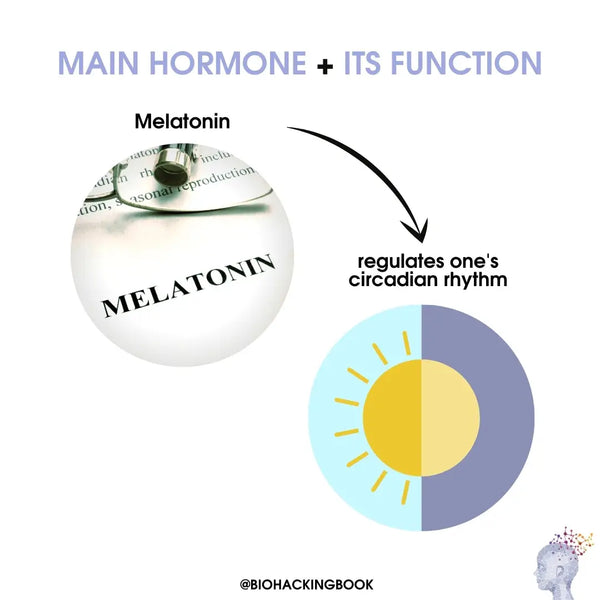
Melatonin is a hormone secreted mostly by the pineal gland during hours of darkness. It primarily regulates the sleep–wake cycle, which is why it's also known as the "hormone of darkness". Needless to say, melatonin is a key factor in the processes needed for maintaining natural circadian rhythm, as well as sleep in general and in particular falling in sleep.
Interestingly, a newborn baby only starts producing melatonin at three months old. From then on, the production increases towards adolescence and finally settles down in adulthood. When one reaches middle-age, the production of melatonin starts to decrease again. Research suggests that decreased melatonin levels could be behind the phenomenon of older people sleeping less than younger people.
How to optimize melatonin levels?
The presence and intensity of light are not the only factors affecting melatonin production; its wavelength also has an effect.
During the day:
During the day, blue light from the sun (short wavelength, around 420–485 nm) dominates. This blocks melatonin production and thus keeps us awake, alert and ready to perform.
- Ensure adequate outdoor exposure to blue light in the morning/afternoon
- E.g., go for a 15-minute walk
- Don’t wear sunglasses
- Locate your desk by the window to increase exposure to blue light
Ensuring adequate exposure to blue light, for example, sun in the early parts of the day as well as blocking blue light in the evening (e.g., with Biohacker's blue light blocking glasses) is important for supporting your melatonin secretion, and thus, natural circadian rhythm.
In the evening:
To kickstart melatonin production in the evening, it’s important to decrease blue light exposure and instead increase light at wavelengths of the red spectrum.
- Use dim lighting 2-3h before going to bed
- Wear biohacker’s blue light blocking evening glasses or try our newest addition Biosleep blue- and green light blocking glasses
- Use an app to reduce blue light emission from the screens of your electronic devices such as mobile phones and laptops. For example, try Twilight.
HUMAN GROWTH HORMONE (HGH) ➡️ STIMULATES PROTEIN SYNTHESIS
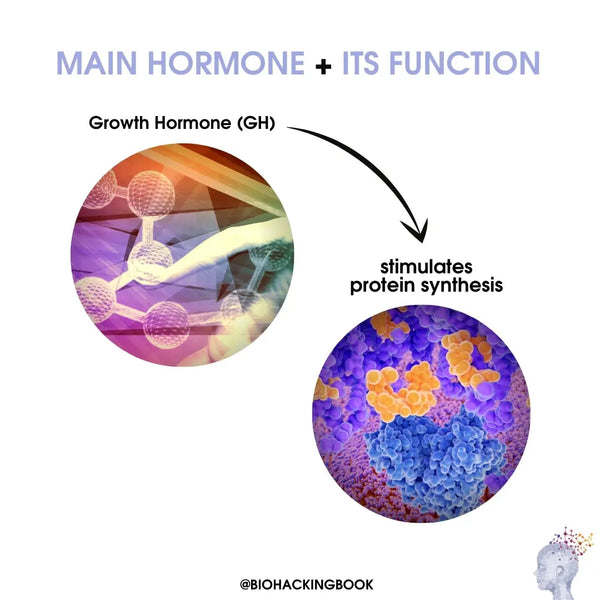
Human growth hormone (HGH) is a hormone produced in the pituitary gland that plays a crucial role in growth and development throughout childhood and thereafter. It is also important for cell repair, metabolism, body composition and muscle growth. Most of HGH is released in pulses during sleep, which is why optimal sleep is important for healthy HGH levels in all ages.
Hence, Optimal levels of HGH are important for overall health and wellbeing. Here are some natural ways to support healthy HGH levels:
- Do intermittent fasting (e.g., 16/8)
- Restrict the intake of sugar and refined carbohydrates
- Do High Intensity Interval Training (HIIT)
- Optimize sleep
ADRENALINE ➡️ ALERTNESS & PERFORMANCE
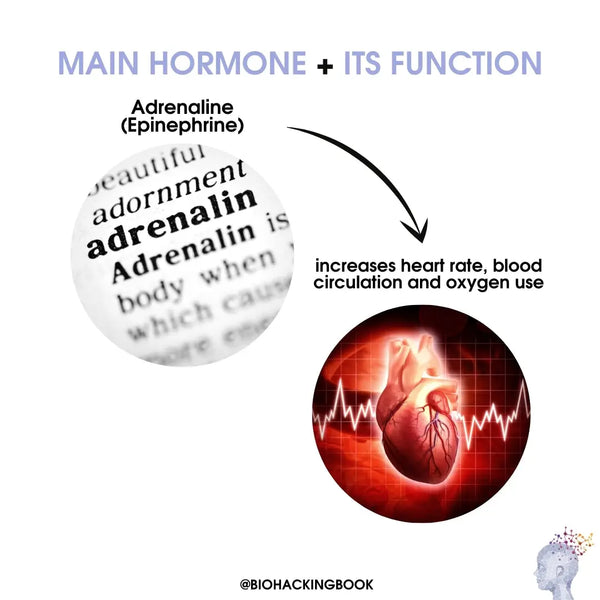
Adrenaline triggers the body's "fight or flight" reaction in response, for example to an external threat, stress or a strong emotional reaction. This reaction in turn increases oxygen uptake and leads to an increase in heart rate and blood circulation. These reactions take place so that you have the best possible ability to cope with the situation. Adrenaline may also protect the body against oxidative stress.
Because of this reaction, adrenaline is an important part of human survival. Sometimes, however, the body secretes the hormone in harmless situations, which for example may lead to momentary dizziness or blurred vision. Because adrenaline releases glucose (which would be needed for survival) in the body, it can lead to restlessness and irritability in a harmless situation.
Prolonged high levels of adrenaline caused by chronic stress can cause persistent nervousness, insomnia, and cardiac symptoms. Thus optimizing stress levels is key when optimizing adrenaline levels.
CORTISOL ➡️ STRESS HORMONE
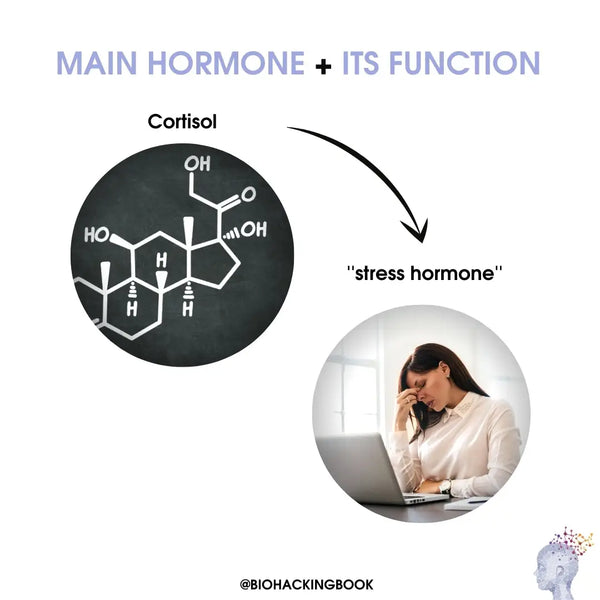
Cortisol is the primary glucocorticoid in the human body. In fact, there is approximately 15–30 mg of cortisol in the bloodstream that is secreted daily in the middle layer or zone (zona fasciculata) of the adrenal cortex.
The adrenal gland secretes cortisol in pulses that follow both the circadian (daily) rhythm and the ultradian (hourly) rhythms. The release of cortisol peaks in the morning, making it easier to wake up and significantly boosting mental energy levels. From there, cortisol production slowly decreases over the course of the day and is normally at its lowest around midnight.
Stress reaction in the body temporarily spikes up cortisol production. Afterward, the cortisol levels usually return to normal. However, chronic stress may cause permanently elevated cortisol production. Therefore, it's important to find individually suitable tools for optimizing stress (and ensure adequate recovery) to optimize cortisol levels.
ENDORPHINS ➡️ RELIEVE PAIN
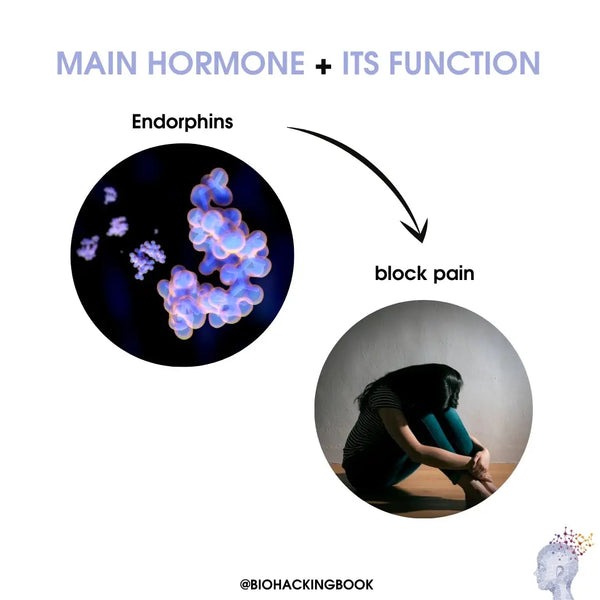
Endorphin is a neuropeptide produced in the pituitary gland and central nervous system that is considered endogenous morphine. This means that endorphins are self-produced in the body for pain-relieving and pleasure-producing effects. These effects are based on the endocannabinoid system where endorphins bind into opioid receptors and thus block pain signals. This results in feelings of pain relief and pleasure, often known as the “endorphin rush”.
Endorphins are produced especially during sleep (highest between 2-4 AM). When awake, endorphins are produced during several (painful or pleasurable) activities, such as:
- Exercise (e.g., runner's high)
- In response to (strong) positive or negative emotions (e.g., laughter & cry)
- Activities one particularly enjoys (e.g., listening to pleasant music)
- Eating
- Sexual activity
INSULIN ➡️ CONTROLS BLOOD GLUCOSE (I.E., BLOOD SUGAR)
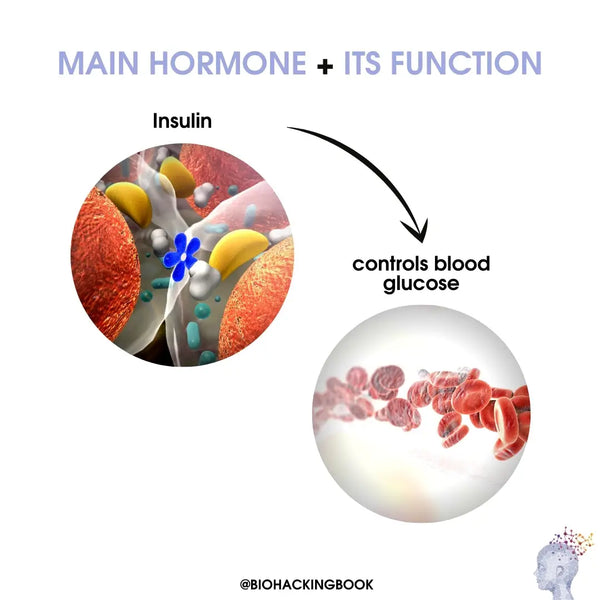
Insulin is a hormone produced and secreted by the beta cells in the pancreas. The body secretes insulin as a response to elevated blood glucose levels that are caused by eating or the secretion of cortisol due to increased stress. Insulin increases glucose absorption and storage and the synthesis of fatty acids and proteins while inhibiting the breakdown of proteins and fatty acids.
The level of insulin is indicative of one’s health. High insulin levels occur in connection with insulin resistance, obesity, metabolic syndrome, insulinoma, Cushing’s syndrome or excessive insulin or corticosteroid doses. Low insulin levels occur in connection with diabetes, hypopituitarism and various pancreatic illnesses. Ideally, the fasting insulin level should be at the lower end of the reference range.
What is insulin sensitivity?
When one eats food high in glucose, one’s blood sugar skyrockets. That’s when insulin kicks in to balance blood glucose levels. When insulin is released, it inhibits lipolysis or the breakdown of fat into energy. If the body's stored insulin levels are consistently elevated, the fatty acids circulating in the blood are stored in the adipose tissue. This in turn leads to weight gain. Insulin sensitivity simply refers to how responsive the cells are to insulin: the higher one’s insulin sensitivity is the more efficient they are in metabolizing glucose. Hence high insulin sensitivity is key for a healthy metabolism.
PROGESTERONE ➡️ THICKENS THE UTERUS LINING DURING MENSTRUAL CYCLE
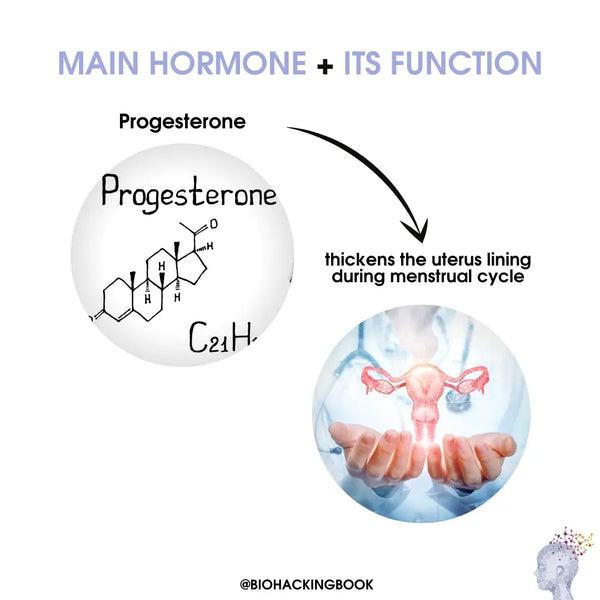
Progesterone is a female specific sex hormone, that is, unlike other sex hormones exclusive to females. Progesterone is a steroid hormone produced in the ovaries, to a lesser extent in the adrenal gland and in the placenta during pregnancy. This hormone impacts women's ability to become and stay pregnant. Progesterone helps prepare the uterus for a fertilized egg. As part of the menstrual cycle, progesterone levels start climbing during ovulation, increase during the days after ovulation and slowly decrease before the menstrual period.
Low progesterone levels
The most common cause for low progesterone levels is chronic stress. Extremely strenuous exercise may also lower progesterone levels. Low progesterone may cause irregular menstrual periods, infertility, acne, brittle nails and dry hair, depression, anxiety, mood swings, weight gain, migraine, headache, and joint ache.
High progesterone levels
High progesterone levels occur in connection with ovarian cysts, excessive progesterone production by the adrenal gland, and some rare types of cancer.
ESTROGEN ➡️ REGULATES FEMALE MENSTRUAL CYCLE

Estrogens are female sex hormones, of which estradiol is one of the main one. Estradiol is a steroid hormone that is synthesized in the ovaries and adrenal glands. Adipose tissue (i.e., fat tissue) also produces small amounts of estradiol. During pregnancy, estradiol is also produced by the placenta. In women, estradiol secretion is regulated by the follicle-stimulating hormone (FSH) produced in the adrenal gland. In men, estradiol is synthesized in the testicles and also created when testosterone is converted into estradiol by the aromatase enzyme.
Estrogen affects various target tissues through estrogen receptors. For example, it is crucial for reproduction and sexual health, bone health, cardiovascular and circulatory system, immune system, sugar metabolism, and nervous system function. In women, estradiol levels vary depending on age, phase of menstrual cycle, and reproductive stage (breastfeeding, pregnancy, etc.). In men, estradiol levels are low and should be below the reference range.
What impacts estrogen levels?
Various environmental factors may increase the levels of estradiol in the body. These so-called endocrine disruptors may form predisposing factors for cancers, diabetes, infertility, and metabolic syndrome as well as various developmental disorders. Examples of these are:
- Xenoestrogens such as microplastics
- BPA and phthalates as well as certain phytoestrogens in food,
- Food additives
- Hormone-treated agricultural products
- Alcohol
- Water contaminated by contraceptive pills
N.B. Some women may have estrogen levels below the reference range. In this case one should consult a physician and consider medicinal treatment options as well as get to the root cause of the problem. However, after menopause, it is normal for estrogen levels to decrease and remain low. If you suffer from symptoms associated with menopause, consult your physician.
TESTOSTERONE ➡️ MALE SEX HORMONE
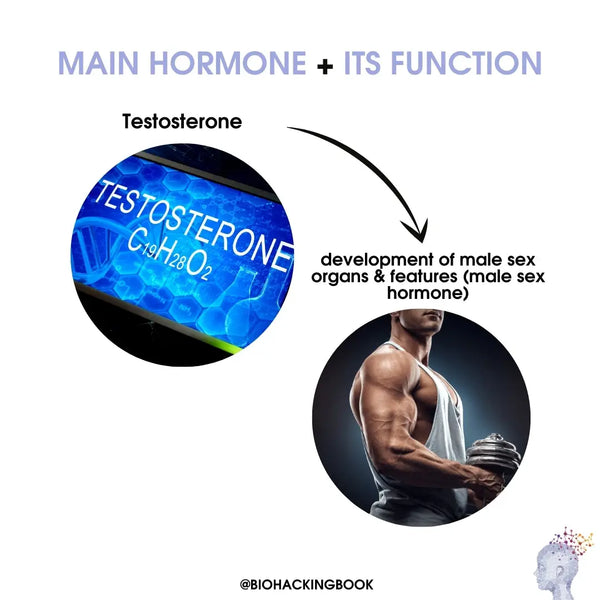
Testosterone is the primary male sex hormone. It is produced predominantly (95%) in the Leydig cells in the testicles and, to a lesser extent, in the adrenal gland in both men and women. Women also produce small amounts of testosterone in the ovaries. Testosterone affects sexual attributes and development. It has significant effects throughout the entire body in both men and women. Testosterone affects the brain, bones and muscle mass, fat distribution, genital tissues, and sexual behavior. Testosterone is also referred as the “anti-aging hormone” – testosterone deficiency is known to be a predisposing factor for premature death. Conversely, higher testosterone levels are linked to longer lifespan in men.
The levels of testosterone secreted follow a daily cycle (similar to cortisol): the highest levels occur in the early hours of the morning and the lowest levels in the evening. The sensitive testosterone method is especially useful in measuring the female testosterone levels, which are categorically more than 10 times lower than in males. Calculating the amount of free testosterone is crucial when determining the biologically active testosterone in the blood.
Factors involved in testosterone production include:
- Diet and micronutrient intake
- Exercise
- Body weight
- Sleep
- Stress
- Environmental toxins
- Some medications
Low testosterone levels
Causes for low testosterone levels include hypothalamus or pituitary gland disease, diabetes, alcoholism, physical testicular injury, testicular malfunction, hyperprolactinemia, or genetic abnormality. Low testosterone levels may cause infertility, low libido, erectile dysfunction, low facial hair growth, reduced muscle mass, and breast enlargement in males (gynecomastia). Low testosterone levels are also linked to increased visceral fat, insulin resistance, and a higher risk of cardiovascular diseases.
High testosterone levels
In men, excessive testosterone levels are usually associated with anabolic steroids use or testicular/ adrenal tumors. In women, excessively high testosterone is typically linked to PCOS, congenital adrenal hyperplasia, or adrenal tumors.
///
How do you support hormonal balance? Tell us in the comments!
Article written & compiled by: Anna Lindfors
Edited by: Olli Sovijärvi





